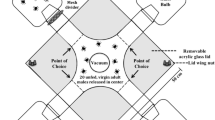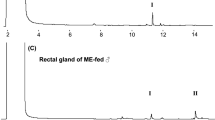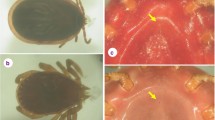Abstract
Neutering of part-fed females eliminated copulatory behavior inDermacentor variabilis (Say) andD. andersoni Stiles males. Extracts from the anterior reproductive tracts of part-fed (7 days) females partly restored the male copulatory behavior in conspecific neutered females. Similar extracts from unfed females did not restore the behavior, suggesting that the pheromone was produced during feeding. Perception of the genital sex pheromone by sensillae on the male cheliceral digits was confirmed by electrophysiological techniques.
Males ofD. variabilis andD. andersoni responsed positively to authentic ecdysone and 20-hydroxyccdysone (20HE) in neutered female bioassays. Responses to sterols were significantly lower than to ecdysteroids. Electrophysiological assays suggest a sensitivity of males to high doses of ecdysteroids. The strongest responses were to 20HE in both species. Ecdysteroids, specifically ecdysone and 20HE were shown to be present in the anterior reproductive tracts in excess of amounts that could be explained by mere hemolymph contamination. Ecdysteroids were also found in washings of the vaginal lumen of these two species.Dermacentor andersoni females contained larger amounts of ecdysteroids thanD. variabilis females. 20-hydroxyecdysone and possibly ecdysone appear to be components of the genital sex pheromone ofD. variabilis andD. andersoni. Species recognition may be facilitated by these components, but the complete mechanism is not yet fully understood.
Similar content being viewed by others
References
Allan, S.A., Phillips, J.S., Taylor, D. and Sonenshine, D.E., 1988. Genital sex pheromone of ixodid ticks: evidence for the role of fatty acids from the anterior reproductive tract ofDermacentor variabilis andDermacentor andersoni. J. Insect. Physiol., 34: 315–323.
Allan, S.A., Phillips, J.S. and Sonenshine, D.E., 1989. Species recognition elcited by differences in composition of the gential sex pheromone inDermacentor variabilis andDermacentor andersoni (Acari: Ixodidae). J. Med. Entomol., 26: 539–546.
Atema, J. and Cowan, D.F., 1986. Sex-identifying urine and molt signals in lobster (Homarus americanus). J. Chem. Ecol., 12: 2065–2080.
Atema, J. and Engstrom, D.G., 1971. Sex pheromone in the lobster,Homarus americanus. Nature (Lond.), 232: 261–263.
Atema, J. and Gagosian, R.B., 1973. Behavioral response of male lobsters to ecdysones. Mar. Behav. Physiol., 2: 15–20.
Binnington, K.C. and Obenchain, F.D., 1982. Circulatory, nervous and neuroendocrine systems of ticks. In: F.D. Obenchain and R. Galun (Editors), Physiology of Ticks. Pergamon Press, New York, pp. 351–399.
Bradshaw, J.W.S., Baker, R. and Lisk, J.C., 1983. Separate orientation and releaser compounds in a sex pheromone. Nature (Lond.), 304: 265–267.
Borst, D.W. and O'Connor, J.D., 1974. Trace analysis of ecdysones by gas-liquid chromatography, radioimmunoassay and bioassay. Steroids, 24: 637–657.
Carde, R.T., Carde, A.M., Hill, A.S. and Roelofs, W.C., 1977. Sex pheromone specificity as a reproductive isolating mechanism among the sibling speciesArchips argyrospilus andA. mortuanus and other sympatric tortricine moths (Lepidoptera: Tortricidae). J. Chem. Ecol., 3: 71–84.
Connat, J.-L., Lafont, R. and Diehl, P.A., 1986. Metabolism of3H ecdysone by isolated tissues of the female ixodid tickAmblyomma hebraeum (Ixodoidea: Ixodidae). Mol. Cell Endocrinol., 47: 257–267.
Dahl, E., Emanuelsson, H. and von Mecklenburg, C., 1970. Pheromone reception in the males of the amphipodGammarus duebeni Lilljeborg. Oikos, 21: 42–47.
Dees, W.H., Sonenshine, D.E. and Breidling, E., 1984. Ecdysteroids in the American dog tick,Dermacentor variabilis (Acari: Ixodidae) during different periods of tick development. J. Med. Entomol., 21: 514–523.
Dichl, P.A., Connat, J.-L., Dirault, J.P. and Lafont, R., 1985. A new class of apolar ecdysteroid conjugates: esters of 20-hydroxy-ecdysone with long-chain fatty acids in ticks. Int. J. Invert. Reprod., 8: 1–13.
Dunham, P.J., 1978. Sex pheromones in crustacea. Biol. Rev., 53: 555–583.
Eales, A.J., 1974. Sex pheromone in the shore crabCarcinus maenas, and the site of its release from females. Mar. Behav. Physiol., 2: 345–355.
Foelix, R.F., 1985. Mechano-and chemoreceptive sensilla. In: F.G. Barth (Editor), Neurobiology of Arachnids. Springer, New York, pp. 118–137.
Frazier, J.L. and Hanson, F.E., 1986. Electrophysiological recording and analysis of insect chemosensory responses. In: J.R. Miller and T.A. Miller (Editors), Insect-Plant Interactions. Springer, New York, pp. 285–330.
Gladney, W.J. and Dawkins, C.C., 1973. Experimental interspecific mating ofAmblyomma maculatum andA. americanum. Ann. Entomol. Soc. Am., 66: 1093–1097.
Gladney, W.J., Grabbe, R.R., Erst, S.E. and Oehler, D.D., 1974. The gulf cost tick: evidence for a pheromone produced by males. J. Med. Entomol., 11: 303–306.
Hamilton, J.G.C. and Sonenshine, D.E., 1988. Evidence for the occurrence of a mounting sex pheromone on the body surface of femaleDermacentor variabilis (Say) andDermacentor andersoni Stiles (Acari: Ixodidae). J. Chem. Ecol., 14: 401–410.
Hendry, L.B., Greeny, P.D. and Grill, R.J., 1973. Kairomone mediated hostfinding behavior in the parasitic wasp,Orgilus lepidus. Entomol. Exp. Appl., 16: 471–477.
Hodgson, D.A., Lettrin, J.Y. and Roeder, K.D., 1955. Physiology of a primary chemoreceptor unit. Science, 122: 417–418.
Hoogstraal, H. and Kim, K.C., 1985. Tick and mammal coevolution, with emphasis onHaemaphysalis. In: K.C. Kim (Editor), Coevolution of Parasitic Arthropods and Mammals. Wiley, New York, pp. 505–568.
Khalil, G.M., Nada, S.A. and Sonenshine, D.E., 1981. Sex pheromone regulation of mating behavior in the camel tick,Hyalomma dromedarii (Ixodoidea: Ixodiae). J. Parasitol., 67: 70–76.
Khalil, G.M., Sonenshine, D.E., Sallam, O. and Homsher, P.J., 1983. Mating regulation and reproductive isolation in the camel ticks,Hyalomma dromedarii andHyalomma anatolicum excavatum (Ixodoidea: Ixodidae). J. Med. Entomol., 20: 136–145.
Kittredge, J.S. and Takahashi, F.T., 1972. The evolution of sex pheromone communication in Arthropods. J. Theor. Biol., 35: 467–471.
Kittredge, J.S., Terry, M. and Takahashi, F.T., 1971. Sex pheromone activity of the molting hormone, crustecdysone, on male crabs (Pachygrapsus crassipes, Cancer antennarius andC. anthonyi). Fish Bull., U.S., 69: 337–343.
Lafont, R., Pennetier, J.-L., Andrianjafintrimo, M., Claret, J., Modde, J.-F. and Blais, C., 1982. Sample processing for high-performance liquid chromatography of ecdysteroids. J. Chromatogr., 236: 137–149.
McLeese, D.W., 1970. Detection of dissolved substances by the American lobster (Homarus americanus). J. Fish. Res. Board Can., 27: 1371–1378.
Roelofs, W.L., 1979. Production and perception of Lepidopterous pheromone blends. In: F.J. Ritter (Editor), Chemical Ecology: Odour Communication in Animals. Elsevier/North Holland, Amsterdam, pp. 159–168.
Schoeni, R., Hess, E., Blum, W. and Ramstein, K., 1984. The aggregation-attachment pheromone of the tropical bont tickAmblyomma variegatum Fabricius (Acari: Ixodidae). Isolation, identification and action of its active components. J. Insect. Physiol., 30: 613–618.
Sonenshine, D.E., 1985. Pheromones and other semiochemicals of the Acari. Annu. Rev. Entomol., 30: 1–28.
Sonenshine, D.E., Silverstein, R.M., Plumer, E.C., West, J.R. and McCullough, T., 1976. 2,6-dichlorophenol, the sex pheromone of the Rocky Mountain wood tick,Dermacentor andersoni Stiles and the American dog tick,Dermacentor variabilis (Say). J. Chem. Ecol., 2: 201–209.
Sonenshine, D.E., Khalil, G.M., Homsher, P.J. and Mason, S.N., 1982.Dermacentor variabilis andDermacentor andersoni: genital sex pheromones. Exp. Parasitol., 54: 317–330.
Sonenshine, D.E., Homsher, P.J., Carson, K.A. and Wang, V.B.: 1984. Evidence of the role of the cheliceral digits in the perception of genital sex pheromones during mating in the American dog tick,Dermacentor variabilis (Say) (Acari: Ixodidae). J. Med. Entomol., 21: 296–306.
Sonenshine, D.E., Homsher, P.J., Beveridge, M. and Dees, W.H., 1985a. Occurrence of ecdysteroids in specific body organs of the camel tick,Hyalomma dromedarii and the American dog tick,Dermacentor variabilis (Acari: Ixodidae) with notes on their synthesis from cholesterol. J. Med. Entomol., 22: 301–311.
Sonenshine, D.E., Silverstein, R.M., Brossut, R., Davis, E.E., Taylor, D., Carson, K.A., Homsher, P.J. and Wang, V.B., 1985b. Genital sex pheromones of ixodid ticks: 1. Evidence of occurrence in anterior reproductive tract of American dog tick,Dermacentor variabilis (Say) (Acari: Ixodidae). J. Chem. Ecol., 11: 1669–1694.
Sonenshine, D.E., Boland, L.M., Beveridge, M. and Upchurch, B.T., 1986a. Metabolism of ecdysone and 20-hydroxyecdysone in the camel tick,Hyalomma dromedarii (Acari: Ixodidae). J. Med. Entomol., 23: 630–650.
Sonenshine, D.E., Taylor, D. and Carson, K.A., 1986b. Chemically mediated behavior in Acari: Adaptations for finding hosts and mates. J. Chem. Ecol., 12: 1091–1108.
Taylor, D., Phillips, J.S., Allan, S.A. and Sonenshine, D.E., 1987. Absence of assembly pheromones in the hard ticksDermacentor variabilis andDermacentor andersoni (Acari: Ixodidae). J. Med. Entomol., 24: 628–632.
Vinson, S.B., Jones, R.L., Sonnet, P.E., Bierl, B.A. and Beroza, M., 1975. Isolation, identification and synthesis of host-seeking stimulants forCardiochiles nigriceps, a parasitoid of tobacco budworm. Entomol. Exp. Appl., 18: 443–450.
Waladde, S.M. and Rice, M.J., 1982. The sensory basis of tick feeding behavior. In: F.E. Obenchain and R. Galun (Editors), Physiology of Ticks, Vol. 1. Pergamon Press, Oxford, pp. 71–118.
Wigglesworth, K.P., Lewis, D. and Rees, H.H., 1985. Ecdysteroid titre and metabolism to novel apolar derivatives in adult femaleBoophilus microplus (Ixodidae). Arch. Insect Biochem. Physiol., 2: 39–54.
Author information
Authors and Affiliations
Additional information
Supported by grant AI10, 986 from the National Institute of Allergy and Infectious Diseases, National Institutes of Health, U.S. Public Health Service, Department of Health and Human Services, Bethesda, Maryland.
Rights and permissions
About this article
Cite this article
Taylor, D., Phillips, J.S., Sonenshine, D.E. et al. Ecdysteroids as a component of the genital sex pheromone in two species of hard ticks,Dermacentor variabilis andDermacentor andersoni (Acari: Ixodidae). Exp Appl Acarol 12, 275–296 (1991). https://doi.org/10.1007/BF01193473
Accepted:
Issue Date:
DOI: https://doi.org/10.1007/BF01193473




